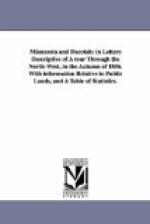It would not be more surprising to have Eastern people doubt some of the statements concerning the growth of Western towns, than it was for the king of Siam to doubt that there was any part of the world where water changed from liquid to a hard substance. His majesty knew nothing about ice. Now, there are a good many handsome villages in the East which hardly support one store. Not that people in such a village do not consume as much or live in finer style; but the reason is that they are old settlers who produce very much that they live on, and who, by great travelling facilities, are able to scatter their trading custom into some commercial metropolis. Suppose, however, one of your large villages to be so newly settled that the people have had no chance to raise anything from their gardens or their fields, and are obliged to buy all they are to eat and all that is to furnish their dwellings, or equip their shops, or stock their farms; then you have a state of things which will support several stores, and a whole catalogue of trades. It is a state of affairs which corresponds with every new settlement in the West; or, indeed, which faintly compares with the demand for everything merchantable, peculiar in such places. Then again, besides the actual residents in a new place, who have money enough in their pockets, but nothing in their cellars, there is generally a large population in the back country of farmers and no stores. Such people come to a place like this to trade, for fifteen or twenty miles back, perhaps; and it being a county seat they have other objects to bring them. At the same time there is an almost constant flow of settlers through the place into the unoccupied country to find preemption claims, who, of course, wish to take supplies with them. The settler takes a day, perhaps, for his visit in town to trade. Time is precious with him, and he cannot come often. So he buys, perhaps, fifty or a hundred dollars worth of goods. These are circumstances which account for activity of business in these river towns, and which, though they are strikingly apparent here, are not peculiar to this town. At first, I confess, it was a mystery to me what could produce such startling and profitable trade in these new towns.
It was in the immediate vicinity of St. Cloud that Gov. Stevens left the Mississippi on his exploration, in 1853, of a railroad route to the Pacific. Several crossings of the river had been previously examined, and it was found that one of the favorable points for a railroad bridge over it was here. I might here say that the country directly west lies in the valley of Sauk River, and from my own observation I know it to be a good farming country; and I believe the land is taken up by settlers as far back as twelve miles. It is a little upwards of a hundred miles in a westerly direction from St. Cloud to where the expedition first touched the Bois des Sioux (or Sioux Wood River). Gov. Stevens says in his report—




